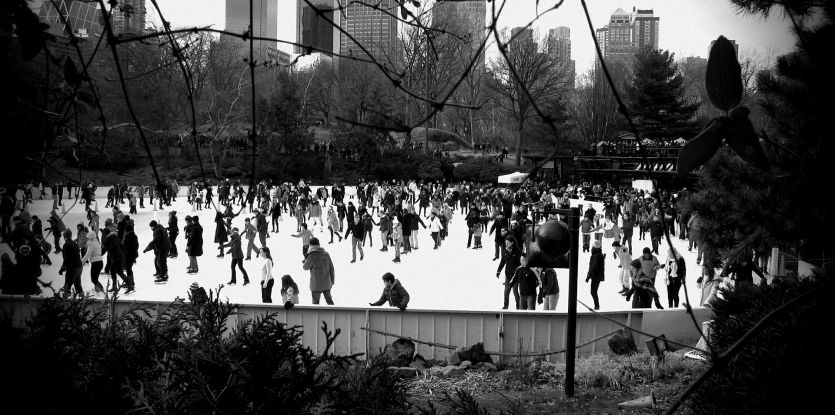Dear Reb Simon,
I am a professional skier. Alas, for every fall I have taken in skiing, my falls in real life have been far more plentiful and painful. Life can be very slippery, and I must tell you that your writings have helped me find hope. I was wondering if you can shed some light on how to navigate our way on the slippery slopes of life.
With the many slips and falls we witnessed in the figure skating competition during the recent Turin Olympics, I thought that perhaps your readers would find this topic timely.
Respectfully,
What causes us to slip? Whether on ice or in a nervous moment, why do we lose our balance?
Scientists have posited various theories to explain the slipperiness of ice. In a recent article in Physics Today, Why is Ice Slippery? Robert M. Rosenberg, an emeritus professor of chemistry at Lawrence University, debunks the popular theory that pressure from an object—a skater pushing off, for example—melts the top layer of ice making it slippery.
Dr. Rosenberg explains that this assumption is false, because the pressure-melting effect is too small to account for the slippage that occurs even at much colder temperatures. The pressure-melting theory also fails to explain why someone wearing flat-bottom shoes, which has a greater surface area than ice skates and exerts even less pressure on the ice, can also slip on ice.
Two alternative explanations have arisen to take the pressure argument’s place. One invokes friction: the rubbing of a skate blade or a shoe bottom over ice heats the ice and melts it, creating a slippery layer. The other, originally proposed by physicist Michael Faraday in 1850, holds that the surface of ice has an intrinsic liquid layer. Water molecules at the ice surface vibrate more than is usual for a solid, because there are no molecules above them to help hold them in place, and they thus remain an unfrozen liquid even at temperatures far below freezing. Scientists describe the surface as having liquid properties, but not fluid.
But both these theories have their own flaws. According to the friction theory, the question still remains why ice is slippery even when a person just stands on ice and generates no heat through friction. According to the latter liquid-layer theory, the layer is too thin to contribute much to slipperiness except near the melting temperature.
Allow me to submit an additional dimension. Perhaps the question should be asked the other way around: Why don’t we always slip on every surface? What causes us to remain steady on solid ground?
The answer is friction. When two bodies rub against each other they create a force that resists motion, thus preventing slipping or falling. But the condition for this is that the two bodies have to have something in common. If the surface is made of a substance that has no common denominator with our feet we will be unable to remain steady on the surface.
Take water for example. We cannot stand on water because water is not solid, and therefore cannot support a solid substance that is heavier than water. Thus, on water we don’t merely slip; we sink, because there is no friction at all between our solid feet and liquid water. Similarly, the other elements, like fire and air, which are gaseous in nature, are also unable to supply support for matter that is more substantial. Earth, by contrast, is a solid substance similar to our feet, and therefore can support our weight, and causes friction to keep us balanced.
Ice, which is frozen water, consists of two paradoxical qualities: On one hand it is a solid, which causes some friction. Thus, we don’t sink into ice, and with care we can walk on it. On the other hand, ice is essentially water, albeit not in liquid form but congealed, yet still water, an entity “foreign” to earth, and therefore causes a very low level of friction. (Indeed, ice is less dense than the liquid form, which is why ice floats on water). And if the ice gets too watery we will be unable to stand firm.
According to the mystics, land and water are not just two different, but two diametrically opposed entities. Land reflects “revealed” and conscious experience; water manifests the “hidden” and unconscious. At opposite ends of the spectrum, land and water represent the finite and the infinite. These two divergent “universes” have a tenuous relationship, and must be separated by an intrinsic boundary lest the water flood the land. We therefore cannot “walk” on water only on land.
The ultimate objective is to bridge land and water, the finite and the infinite, matter and spirit. [For this reason these two worlds were united once in history at the parting of the sea to empower us with this ability]. This unity, however, is achieved through a long process of refining the material, finite “land” and acclimating it to contain the infinite spirit of “water.”
Ice is an intermediary between water and land. It has something common both with water and land; it is both solid and liquid. We can walk on ice, yet the ice is slippery. The slipperiness is caused by the fact that two “worlds” – land and water – are rubbing against each other, with a bit of friction but not too much. Ice therefore helps bridge land with the hitherto inaccessible world of water. Yet care must be taken to not to slip on the ice.
The same is true psychologically. We can slip whenever we come in contact with an experience that is foreign to us. When you stay in one place – in your comfort zone – you will not slip. But neither will you move or grow. When you expose yourself to new ideas, to fresh options, there is always the risk of losing your footing.
The key is to have just the right balance between familiarity and movement. Not too much friction and not too little friction. If you move to fast into new territories, there may be too much risk of slippage or even drowning. If you move to slowly growth will be compromised.
So, life is a slippery slope. The secret to navigation is not just to walk on land, but to glide gracefully across the ice. Not just step by step, but to reach for the skies as you scale the mountain.
And above all, to remain connected above, so as not to fall on the slippery slope below.
Two young men once visited a small Russian town in mid-winter. They tried to find the ritual bath (mikveh), and learned that it was at the foot of a steep hill. But the slope leading down to the bath, they were told, grew so dangerously slippery in wintertime that no one used it — no one, that is, except for one very special chassid who went daily.
The young men were skeptical, and decided to follow this man the next morning. To their surprise, he was very old and feeble. Surely, they thought, he cannot possibly make his way down the slope. But he walked steadily down the icy hill as the young men, trying to follow, slipped and fell. They watched in awe as he entered the bathhouse.
Afterwards, they respectfully asked the elderly man how he had made it down the hill. “When one is connected above,’’ he said quietly, “he does not fall below.”








Beautiful!
Thank You!
Yours wise words are perfectly timed!
Thank you so much for this; it surely answers some of my own questions at my falls along the way…
Your reader has found an interesting question, but he seems to have built his pilpul on a less than precise foundation. Since it was published, it seems necessary to clear up a few things.
The liquid-like quality at the surface of ice actually persists even to 235 degrees below zero (2 degrees above absolute zero). The experiments that revealed the liquid-like nature of the surface of ice at ultra low temperatures were done by two different research groups on opposites of the earth using different though related techniques. Both techniques directly measure the ordering or disorder of materials and surfaces.
The suggestion by your reader that the liquid layer is too thin to make ice slippery below the freezing point of water seems unlikely to be correct. It is well known that lubrication can be provided by whetting layers, and also, ice skaters know that cold hard ice is slippery and even preferable to soft ice.
The question of why ice is slippery is indeed interesting, but that ice has a liquid-like surface layer seems to be established and that this may play a role in its slipperiness seems to still be a viable theory.
As to why things have friction, it is ultimately all electrical as is everything in our physical day to day lives. At a crude scale, things with bumps engaging other things with bumps will tend to resist transverse motions. Liquids passing over sufficiently bumpy services also resist flow, though in a perhaps more complicated way. Why do things not pass through each? That’s electrical. At a smaller scale, things that approach intimately enough to interact electrically will also tend to resist relative motion depending on the structure of the interaction. By one way or another, friction can be observed in liquids and between liquids and solids.
These kinds of things are generally not big mysteries anymore at least not as fundamental science. The few mysteries that do come up are more along the lines of figuring out how things that are already known interact in a specific situation. We make theories and do experiments to test the theories, and ultimately we figure most of them out.
There is no question that the correspondence between physical and spiritual is impressive and gives us a feeling of profundity. It is nice that your reader feels moved to offer something. I am sorry to have to deflate some of it. But truth and precision are very important, what is offered has to ultimately hold water.
-Anonymous
RESPONSE:
You write the suggestion by your reader that the liquid layer is too thin to make ice slippery below the freezing point of water seems unlikely to be correct. This suggestion was actually posited by Dr. Miquel Salmeron. (Dr. Salmeron is a colleague of Dr. Gabor A. Somorjais at Lawrence Berkeley Laboratory, who performed the experiment you cite, of bombarding the surface of ice with electrons and observing how they bounced off, producing a pattern that looked at least partially liquid at temperatures down to minus 235 degrees; a conclusion corroborated, as you noted, a couple of years later by a team of German scientists who bounced helium atoms off ice and found similar results).
Dr. Salmeron and colleagues performed the following experiment. They dragged the tip of an atomic force microscope, resembling a tiny phonograph needle, across the surface of ice. We found the friction of ice to be very high, Dr. Salmeron said. That is, ice is not really that slippery, after all. Dr. Salmeron said that this finding indicates that while the top layer of ice may be liquid, it is too thin to contribute much to slipperiness except near the melting temperature. In his view, friction is the primary reason ice is slippery. The microscope tip was so small that its friction melted only a tiny bit of water, which immediately refroze and therefore did not provide the usual lubrication, he said.
Regarding your last statement that there is no question that the correspondence between physical and spiritual is impressive and gives us a feeling of profundity. It is nice that your reader feels moved to offer something. I am sorry to have to deflate some of it. But truth and precision are very important, what is offered has to ultimately hold water — the perspective upon which I base my writing (Torah) sees all knowledge as holistic, in the sense that mysticism and science, as well as all other logical systems and modalities, complement (not replace) each other. Mysticism was never meant to replace science, and it also was never some superstitious way of trying to understand the big mysteries of life. Science tries to explain the natural forces and laws that shape reality and experiences. Mysticism (is not just about giving us a feel of profundity, but) comes to explain the spiritual forces that shape and define another dimension of the same reality and experiences. For example: On the surface level a teardrop tells us that someone may be crying. Science can explain the process how tears well up in the tear ducts and the biological and chemical components of tears. Physics will dissect the atomic and sub-atomic structure of the same phenomenon. Psychology will explain the emotions that cause one to cry. And mysticism will analyze the spiritual forces that shape all the above levels and models. Just as a musical note has a body (the shape of he note) and soul (its sound), everything is comprised of body and soul. The body of ice is discussed in science; its soul in mysticism. And they complement each other.
This holistic approach is based on the axiomatic principle that the universe is driven by a unifying force (G-d). Thus, the various legitimate explanations of any given phenomena are different layers of one way of thinking. And even when things seem fragmented, in truth they are dimensions of an intrinsic unity at work; and a unity, that becomes more profound and more elegant as you travel deeper inward.
So, while we may have science to explain everything from slippery ice to friction, the question still remains why physical phenomenon is shaped in this fashion and not in another. And this is where the mystical can help shine some light, as well as find fascinating parallels between seemingly disconnected modalities, including our own psychological and emotional lives. And above all, inform us in ways that can help us all live richer and more fulfilling lives.
Blessings and best wishes,
Simon Jacobson
RESPONSE:
Mr. Jacobson,
The thoughts of a simple scientist on this subject are not so relevant. In general, a person should not be looking to science or scientists for validation or inspiration. The Torah does not require validation, and, inspiration through contemplation of the Ma’ase Bereshis comes only after an enormous amount of study and effort in both Torah and science.
In practical terms, it takes decades of learning and experience to make a Torah Scholar or a scientist, and here we need both in one person. Short of that accomplishment, a person is simply not equipped on their own to discern truth from fiction. This is of course what sustains much of what is offered under the banner of “Torah Science”.
Rather than become overnight geniuses, or look for intellectual shortcuts, our responsibility is to set up kivios itim morning and evening, and connect ourselves to a Rav and a Mashpia. Is the pot tref? Ask the Rav. Is the idea tref? Also ask the Rav. What is a good resolution for my yom haledus? Ask the Mashpia.
On your comments on my comments on your article about ice, there is much that could be discussed. However, that discussion would take us far a field, it would most likely be very technical and specialized, and few would really find it interesting.
-Anonymous
Dear Rabbi Jaconson,
Many thanks for your time and your supportive words.